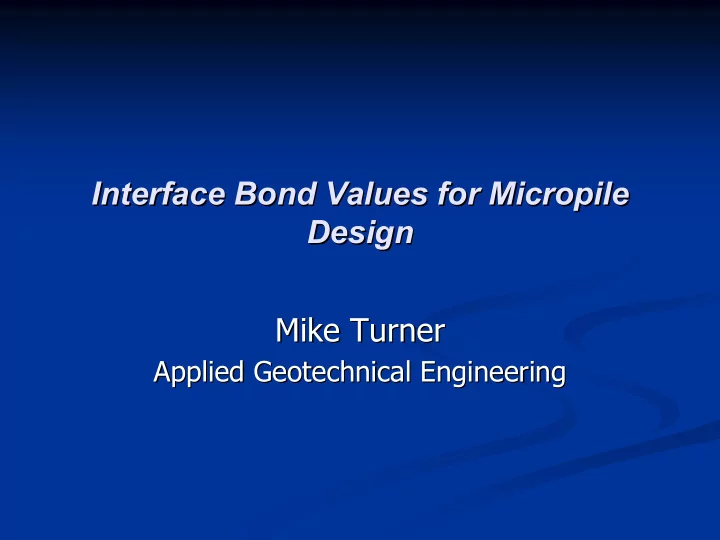

Interface Bond Values for Micropile Interface Bond Values for Micropile Design Design Mike Turner Mike Turner Applied Geotechnical Geotechnical Engineering Engineering Applied
Background: Background: � Micropiles up to 2500kN (250 metric Micropiles up to 2500kN (250 metric � tonnes; 280 US tons) compression tonnes; 280 US tons) compression � 500kN tension 500kN tension � � Base of 500 Base of 500- -750mm (20 to 30 inch) 750mm (20 to 30 inch) � tubular piles tubular piles � Replace large diameter rock sockets Replace large diameter rock sockets � September 2007 Interface Bond Values 2
Design of interfaces: Design of interfaces: (1) Compression: (1) Compression: End- -bearing on micropile head bearing on micropile head End � � Grout- -to to- -reinforcement bond reinforcement bond Grout � � Grout- -to to- -rock bond rock bond Grout � �
Design of interfaces: Design of interfaces: (2) Tension (2) Tension � Grout Grout- -to to- -rock bond rock bond � � Grout to reinforcement bond Grout to reinforcement bond � � Grout Grout- -to to- -tubular steel pile bond tubular steel pile bond � September 2007 Interface Bond Values 4
Grout- -to to- -rock bond: rock bond: Grout Sources of test information: Sources of test information: Ground anchors Ground anchors � � Soil nails Soil nails � � Rock bolts Rock bolts � � Rock dowels Rock dowels � � Conventional bored piles Conventional bored piles � �
Common reference sources: Common reference sources: BS8081:1989 / BS8081:1989 / � � Littlejohn & Bruce 1977 Littlejohn & Bruce 1977 � � Barley 1988 Barley 1988 � � Littlejohn 1980 Littlejohn 1980 � � Cole & Stroud 1977 Cole & Stroud 1977 � � + Stroud 1988 + Stroud 1988
Other test data: Other test data: From Turner et al et al since 1980 since 1980 From Turner � � Attached as Tables 1 and 2 Attached as Tables 1 and 2 � � Table 1: covers rock anchor Table 1: covers rock anchor � � tests up to 1980 up to 1980 tests Table 2: covers ground anchor Table 2: covers ground anchor � � and micropile tests up to and micropile tests up to present- -day day present
Identifiers: Identifiers: Rock type (mainly) Rock type (mainly) � � Geological formation, age etc Geological formation, age etc � � Weathering grades Weathering grades � � Young’s Modulus Young’s Modulus � � UCS UCS � � TCR TCR � � RQD RQD � �
Test values recorded: Test values recorded: Max bond stress (no failure) Max bond stress (no failure) � � Ult bond stress, where achieved Ult bond stress, where achieved � � Max applied test force Max applied test force � � Design bond stress adopted Design bond stress adopted � � (+ drill- -hole diameter) hole diameter) (+ drill � �
Rough conclusions: Rough conclusions: RQD <25% affects bond RQD <25% affects bond � � Chalk bond correlates with SPT Chalk bond correlates with SPT � � Weak mudrocks mudrocks correlate with SPT correlate with SPT Weak � � UCS/10 correlates ‘roughly’ UCS/10 correlates ‘roughly’ � �
Further rouch rouch conclusions: conclusions: Further Micropiles in near surface rocks: Micropiles in near surface rocks: � � reduce bond value by half reduce bond value by half Expect incresing incresing hole diameter hole diameter Expect � � = decreasing bond value. = decreasing bond value. Degree of weathering should Degree of weathering should � � affect bond affect bond
Recommend
More recommend